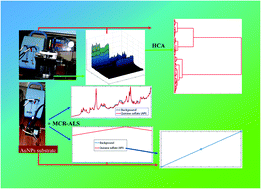Portable and benchtop Raman spectrometers coupled to cluster analysis to identify quinine sulfate polymorphs in solid dosage forms and antimalarial drug quantification in solution by AuNPs-SERS with MCR-ALS†
Abstract
This paper proposes for the first time: (a) a qualitative analytical method based on portable and benchtop backscattering Raman spectrometers coupled to hierarchical cluster analysis (HCA) and multivariate curve resolution – alternating least-squares (MCR-ALS) to identify two polymorphs of antimalarial quinine sulfate in commercial pharmaceutical tablets in their intact forms and (b) a quantitative analytical method based on gold nanoparticles (AuNPs) as active substrates for surface-enhanced Raman scattering (SERS) in combination with MCR-ALS to quantify quinine sulfate in commercial pharmaceutical tablets in solution. The pure concentration and spectral profiles recovered by MCR-ALS proved that both formulations present different polymorphs. These results were also confirmed by two clusters observed in the HCA model, according to their similarities within and among the samples that provided useful information about the homogeneity of different pharmaceutical manufacturing processes. AuNPs-SERS coupled to MCR-ALS was able to quantify quinine sulfate in the calibration range from 150.00 to 200.00 ng mL−1 even with the strong overlapping spectral profile of the background SERS signal, proving that it is a powerful ultrahigh sensitivity analytical method. This reduced linearity was validated throughout a large calibration range from 25.00 to 175.00 μg mL−1 used in a reference analytical method based on high performance liquid chromatography with a diode array detector (HPLC-DAD) coupled to MCR-ALS for analytical validation purposes, even in the presence of a coeluted compound. The analytical methods developed herein are fast, because second-order chromatographic data and first-order SERS spectroscopic data were obtained in less than 6 and 2 min, respectively. Concentrations of quinine sulfate were estimated with low root mean square error of prediction (RMSEP) values and a low relative error of prediction (REP%) in the range 1.8–4.5%.



 Please wait while we load your content...
Please wait while we load your content...